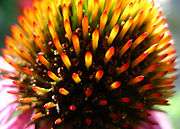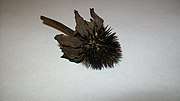Echinacea purpurea
Echinacea purpurea (eastern purple coneflower,[2] purple coneflower, hedgehog coneflower, or echinacea) is a North American species of flowering plant in the sunflower family.[3] It is native to parts of eastern North America[4] and present to some extent in the wild in much of the eastern, southeastern and midwestern United States as well as in the Canadian Province of Ontario. It is most common in the Ozarks and in the Mississippi/Ohio Valley.[5][6] Its habitats include dry open woods, prairies and barrens.
| Echinacea purpurea | |
|---|---|
 | |
| At a prairie preserve in southwest Arkansas | |
| Scientific classification | |
| Kingdom: | Plantae |
| Clade: | Tracheophytes |
| Clade: | Angiosperms |
| Clade: | Eudicots |
| Clade: | Asterids |
| Order: | Asterales |
| Family: | Asteraceae |
| Genus: | Echinacea |
| Species: | E. purpurea |
| Binomial name | |
| Echinacea purpurea | |
| Synonyms[1] | |
| |
Taxonomy
'Echinacea' is derived from Greek, meaning ‘spiny one’, in reference to the spiny sea urchins 'εχίνοι'. 'Purpurea' means 'reddish-purple'.[7] Originally named Rudbeckia purpurea by Linnaeus in 1753 in Species plantarum 6 , it was reclassified in 1794 by Conrad Moench , in a new genus named Echinacea purpurea (L.). In 1818, Thomas Nuttall describes a new variety that he named Rudbeckia purpurea var. serotina. Just two decades later, De Candolle raises him to the rank of species of the other genus Echinacea serotina (Nutt.) DC. (1836).[8] In 2002, Binns et al. discovered a misapplication of the name Echinacea purpurea (L.) Moench for the taxon correctly named Echinacea serotina (Nutt.) DC. in 1836. The authors proposed to retain the names not to cause confusion among gardeners and herbalists.[9]
Description
Echinacea purpurea is an herbaceous perennial up to 120 cm (47 in) tall by 25 cm (10 in) wide at maturity. Depending on the climate, it blooms throughout summer into autumn. Its cone-shaped flowering heads are usually, but not always, purple in the wild. Its individual flowers (florets) within the flower head are hermaphroditic, having both male and female organs in each flower. It is pollinated by butterflies and bees. The alternate leaves, borne by a petiole from 0 to 17 cm, are oval to lanceolate, 5-30 x 5-12 cm; the margin is tightened to toothed.
The inflorescence is a capitulum, 7 to 15 cm in diameter, formed by a prominent domed central protuberance consisting of multiple small yellow florets. These are surrounded by a ring of pink or purple ligulate florets. The tubular florets are hermaphrodite while the ligular florets are sterile. The involucral bracts are linear to lanceolate. The plant prefers well-drained soils in full sun.[2] The fruit is an achene, sought after by birds.
 Close-up showing many individual flowers comprise the flowerhead
Close-up showing many individual flowers comprise the flowerhead In cultivation
In cultivation Dried spines
Dried spines
Cultivation
Echinacea purpurea is also grown as an ornamental plant in temperate regions. It is ideal for curbs, walkways or beds. The flowers can also go into the composition of fresh bouquets. Numerous cultivars have been developed for flower quality and plant form.[3] The plant grows in sun or light shade.[10] It thrives in either dry or moist soil and can tolerate drought once established. The cultivars 'Ruby Giant'[11] and Elton Knight='Elbrook'[12] have gained the Royal Horticultural Society's Award of Garden Merit.[13]
Propagation
Echinacea purpurea can be propagated either vegetatively or from seeds.[4] Useful vegetative techniques include division, root cuttings, and basal cuttings. Clumps can be divided, or broken into smaller bunches, which is normally done in the spring or autumn. Cuttings made from roots that are "pencil-sized" will develop into plants when started in late autumn or early winter.[3] Cuttings of basal shoots in the spring may be rooted when treated with rooting hormones, such as IBA at 1000 ppm.[14]
Seed germination occurs best with daily temperature fluctuations[4] or after stratification,[15] which help to end dormancy. Seeds may be started indoors in advance of the growing season or outdoors after the growing season has started.
Ecology
Slugs eat this plant.[4] Rabbits will also eat the foliage when young, or shortly after emerging in the spring.[16] Additionally, roots can be damaged and eaten by gophers.[5]
Chemistry
Echinacea purpurea contains multiple secondary metabolites that are produced by this plant. They include: alkamides, caffeic acid derivatives, polysaccharides, and glycoproteins. The secondary metabolites are believed to be biologically and pharmacologically active.[17] More specifically the glycoproteins of echinacea root extract has the ability to activate portions of the immune system, and is what heavily contributes to the immune system stimulation by echinacea.[18] Nicotiflorin is the dominant flavonid in echinacea, followed by the flavonid rutin.[19]
As medicine
Native Americans used the plant to treat many ailments, including wounds, burns, insect bites, toothaches, throat infections, pain, cough, stomach cramps, and snake bites.[20]
The plant is important economically to the pharmaceutical trade. It is purported that all parts of the purple coneflower stimulate the immune system.[10] With the increase style of a sedentary lifestyle, herbal drugs have increased in popularity to treat immunodeficient issues.[19] In more recent years, research into immune benefits of Echinacea has been linked to investigating immune benefits with upper respiratory tract infections.[21] Research on immune benefits mostly focus on the roots of Echinacea and extraction through high-performance liquid chromatographic analysis.[22]
Well-controlled trials studying these uses are limited and low in quality.[23][24][25][26] Study results are mixed on whether preparations including Echinacea can be useful for upper respiratory tract infections including colds.[27] More recent studies have showed that the anti-inflammatory effects of this flower is due to its ability to stimulate the innate immune system, thus suggesting innate immunity is improve in the presence of this plant.[17] It has also show a multitude of other biological healthy benefits, such as: anti-anxiety, anti-depression, cytotoxicity, and antimutagenicity effects induced by the plant and has been revealed in various studies.[17] Though while some studies show patients have no side effects, others report sever side effects, such as abdominal pain, angioedema, dyspnea, nausea, pruritus, rash, erythema, and urticaria.[17]
Echinacea purpurea is used in pharmaceutics because of its ability to mobilize leukocytes, activate phagocytosis activation and fibroblast stimulation.[17] It has been implemented in chemotherapy medications and is one of the most widely medical manufactured species of its genus.[17] Secondary metabolite group alkamides, have been linked with being responsible for the plant's immunomodulatory and psychoactive activities.[17] This plant also increase NF-κB activation, which is a protein complex that deals with cell survival. NF-κB is responsible and linked to expression of other genes that are critically important to the immune system. Interestingly enough, studies have shown that in the absence of any natural stimulant of the immune system, like a scrape or injury, the plant has no regulatory effect on NF-kB expression.[17] Therefore evidence indicates that the plant only with its activated secondary metabolites, cause expression of NF-kB, and other major players of the immune system like, macrophages, neutrophils, and DCs.[17] Though results in many studies show without a doubt, an immunity role for Echinacea purpurea it cannot be without out certain that this is the case.[17] Many study results raise even further questions about some contradictory immunity stimulation by Echinacea purpurea.[17]
References
- The Plant List, Echinacea purpurea (L.) Moench
- "Eastern purple coneflower, Echinacea purpurea (Linnaeus) Moench, Methodus. 591. 1794". Flora of North America.
- Zimmerman B. "Echinacea: Not always a purple coneflower". Gardening. Archived from the original on 2016-03-04. Retrieved 2009-08-26.
- "Echinacea purpurea - (L.)Moench". Plants For A Future. June 2004. Retrieved 2007-06-06.
- "Echinacea purpurea (L.) Moench (eastern purple coneflower)". PLANTS Profile. United States Department of Agriculture Natural Resources Conservation Service. Retrieved 2007-06-07.
- "2014 county distribution map of Echinacea purpurea". The Biota of North America Program.
- Gledhill D (2008). The Names of Plants. Cambridge University Press. pp. 149, 321. ISBN 9780521866453.
- He Y, Kaarlas M (2014). "Popularity, Diversity and Quality of Echinacea". In Miller SC, Yu H (eds.). Echinacea: The genus Echinacea. CRC Press.
- Binns SE, et al. (2014). Miller SC, Yu H (eds.). Echinacea: The genus Echinacea. CRC Press.
- Midgley JW (1999). Southeastern Wildflowers: Your complete guide to plant communities, identification, and traditional uses. Crane Hill Publishers. ISBN 978-1-57587-106-6.
- "RHS Plant Selector - Echinacea purpurea 'Ruby Giant'". Retrieved 4 June 2020.
- "RHS Plantfinder - Echinacea 'Elbrook'". Retrieved 4 June 2020.
- "AGM Plants - Ornamental" (PDF). Royal Horticultural Society. July 2017. p. 33. Retrieved 6 February 2018.
- Carey D, Avent T. "Echinacea Explosion - The Purple Coneflower Chronicles". Plant Delights Nursery Article. Plant Delights Nursery. Retrieved 2015-07-12.
- USDA Natural Resources Conservation Service. Eastern Purple Coneflower (Echinacea purpurea)
- "Echinacea – How To Grow Purple Coneflower". Growit Buildit. 2018-09-16. Retrieved 25 September 2018.
- Manayi A, Vazirian M, Saeidnia S (2015). "Echinacea purpurea: Pharmacology, phytochemistry and analysis methods". Pharmacognosy Reviews. 9 (17): 63–72. doi:10.4103/0973-7847.156353. PMC 4441164. PMID 26009695.
- Bodinet, C.; Beuscher, N. (December 1991). "Antiviral and Immunological Activity of Glycoproteins from Echinacea purpurea Radix". Planta Medica. 57 (S 2): A33–A34. doi:10.1055/s-2006-960283. ISSN 0032-0943.
- Kurkin, V. A.; Akushskaya, A. S.; Avdeeva, E. V.; Velmyaikina, E. I.; Daeva, E. D.; Kadentsev, V. I. (2011-12-01). "Flavonoids from Echinacea purpurea". Russian Journal of Bioorganic Chemistry. 37 (7): 905–906. doi:10.1134/S1068162011070120. ISSN 1608-330X.
- Wang L, Waltenberger B, Pferschy-Wenzig EM, Blunder M, Liu X, Malainer C, et al. (November 2014). "Natural product agonists of peroxisome proliferator-activated receptor gamma (PPARγ): a review". Biochemical Pharmacology. 92 (1): 73–89. doi:10.1016/j.bcp.2014.07.018. PMC 4212005. PMID 25083916.
- Billah, Md. M.; Hosen, Md. B.; Khan, Fazlullah; Niaz, Kamal (2019-01-01), Nabavi, Seyed Mohammad; Silva, Ana Sanches (eds.), "Chapter 3.13 - Echinacea", Nonvitamin and Nonmineral Nutritional Supplements, Academic Press, pp. 205–210, doi:10.1016/b978-0-12-812491-8.00029-1, ISBN 978-0-12-812491-8, retrieved 2020-04-22
- Paek, Kee-Yoeup; Murthy, Hosakatte Niranjana; Hahn, Eun-Joo (2009), Jain, S. Mohan; Saxena, Praveen K. (eds.), "Establishment of Adventitious Root Cultures of Echinacea purpurea for the Production of Caffeic Acid Derivatives", Protocols for In Vitro Cultures and Secondary Metabolite Analysis of Aromatic and Medicinal Plants, Methods in Molecular Biology, Humana Press, pp. 3–16, doi:10.1007/978-1-60327-287-2_1, ISBN 978-1-60327-287-2, retrieved 2020-04-22
- Hart A, Dey P (2009). "Echinacea for prevention of the common cold: an illustrative overview of how information from different systematic reviews is summarised on the internet". Preventive Medicine. 49 (2–3): 78–82. doi:10.1016/j.ypmed.2009.04.006. PMID 19389422.
- Shah SA, Sander S, White CM, Rinaldi M, Coleman CI (July 2007). "Evaluation of echinacea for the prevention and treatment of the common cold: a meta-analysis". The Lancet. Infectious Diseases. 7 (7): 473–80. doi:10.1016/S1473-3099(07)70160-3. PMC 7106401. PMID 17597571.
- Woelkart K, Linde K, Bauer R (May 2008). "Echinacea for preventing and treating the common cold". Planta Medica. 74 (6): 633–7. doi:10.1055/s-2007-993766. PMC 4068831. PMID 18186015.
- Karsch-Völk M, Barrett B, Kiefer D, Bauer R, Ardjomand-Woelkart K, Linde K (February 2014). "Echinacea for preventing and treating the common cold". The Cochrane Database of Systematic Reviews (Systematic review). 2 (2): CD000530. doi:10.1002/14651858.CD000530.pub3. PMC 4068831. PMID 24554461.
- "Echinacea". National Center for Complementary and Integrative Health. 2011-11-09.